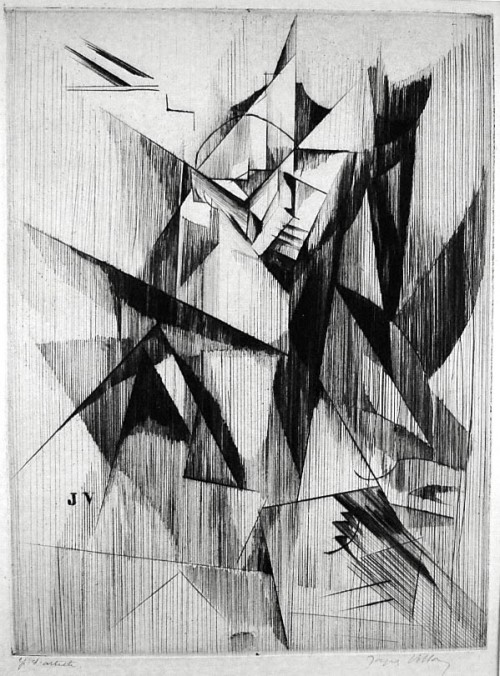Monsieur D. Lisant (Portrait of the Artist’s Father, Reading)
 Jacques Villon (1875-1963), Monsieur D. Lisant (Portrait of the Artist’s Father, Reading), drypoint, 1913, signed in pencil lower right and inscribed “ep. d’artiste” lower left margins [initaled in the plate lower left JV]. Ginestet and Poullion E284. An artist’s proof; the edition size was 32. On Rives laid paper, with the watermark Eug. Delatre. In excellent condition, the full sheet with deckle edges, 19 1/2 x 14 3/8, the sheet 21 5/8 x 14 7/8 inches.
Jacques Villon (1875-1963), Monsieur D. Lisant (Portrait of the Artist’s Father, Reading), drypoint, 1913, signed in pencil lower right and inscribed “ep. d’artiste” lower left margins [initaled in the plate lower left JV]. Ginestet and Poullion E284. An artist’s proof; the edition size was 32. On Rives laid paper, with the watermark Eug. Delatre. In excellent condition, the full sheet with deckle edges, 19 1/2 x 14 3/8, the sheet 21 5/8 x 14 7/8 inches.
A fine proof impression, with rich burr. (the edition was 32).
Provenance: Collection of Francey and Dr. Martin L. Gecht. (Shown at the Exhibit “Graphic Modernism: Selections from The Collection of Francey and Dr. Martin L. Gecht at the Art Institute of Chicago, Nov. 15 2003-Jan. 11, 2004)
The rich burr in this impression is blacker and more velvety than the numbered impressions from the edition we have seen; this is an earlier impression. The burr is comparable to the trial proof impression at the Philadelphia Museum of Art; that impression is, however, less cleanly wiped.
Monsieur D. Lisant represents a culmination of Villon’s efforts in cubist portraiture, and it was the last of the great cubist prints of 1913. The composition is abstract, but not entirely so (e.g., the details of the face are clearly legible, the hands and book at the lower right somewhat less so). The brilliant crystalline structure of converging planes gives the composition a striking sense of movement.
Villon began his career as a printmaker, and this perhaps explains his lifelong focus on printmaking. Monsieur D. Lisant demonstrates how printmaking – especially drypoint – was an ideal medium for Villon’s cubist prints. Planes, angles, regularized shading, screening, all work spendidly. Even a century after the invention of cubism Monsieur D. Lisant continues to strike the viewer as a bit shocking, and invites one to look long and hard at what the future might bring.